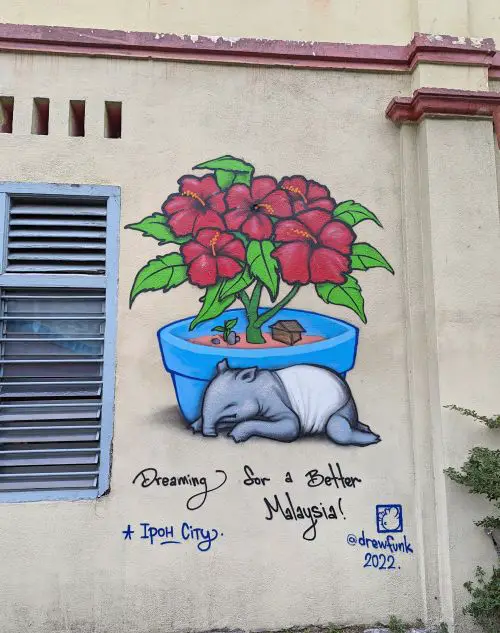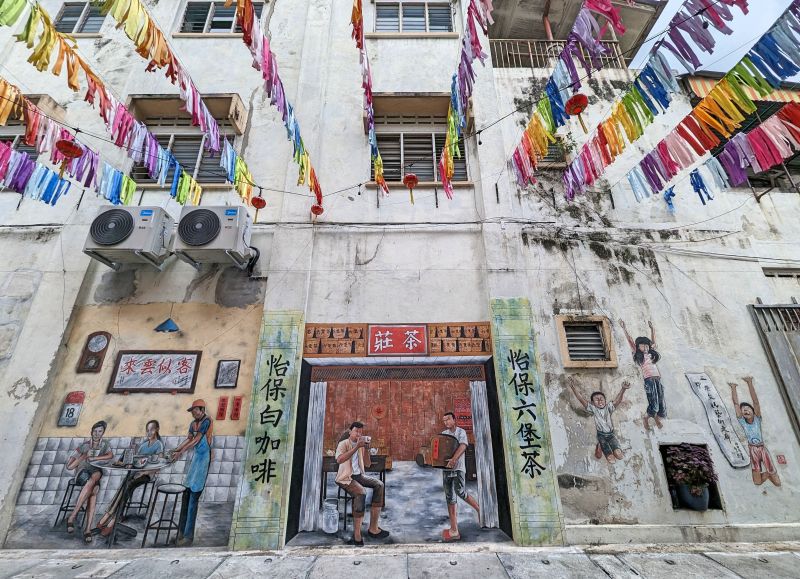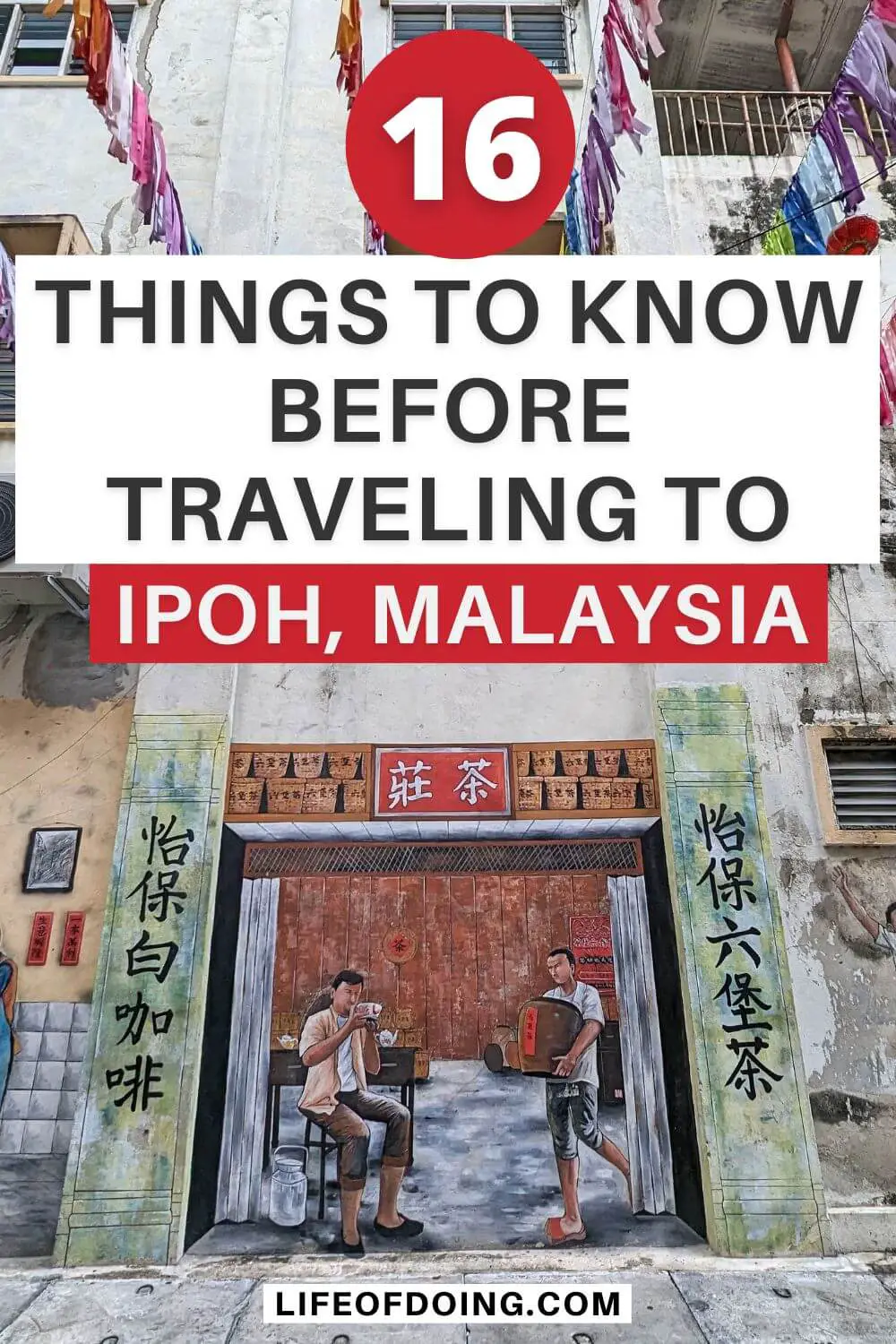Interested in visiting Ipoh, Malaysia? We recommend reading our previous post on the top reasons to visit Ipoh for inspiration.
As a former tin mining city, this small city is rich with history and culture, and has plenty of interesting attractions for everyone. For food lovers, we recommend eating as much delicious and flavorful Malaysian cuisine.
Since it can be confusing where to start with planning a trip, we put together an overview of all the things to know before going to Ipoh, Malaysia. A few questions came up during our initial travel planning so we wanted to share our knowledge and experience.
After reading these practical travel tips for Ipoh, we want you to feel more confident with planning a trip here.
*Disclaimer: This post contains affiliate links. If you click on them and make a purchase, we receive a small commission. There is no additional cost to you. Appreciate the support.
1. It’s conveniently located between Kuala Lumpur and Penang.
Whether you’re starting or ending your Malaysia trip from Penang or Kuala Lumpur (KL), you can easily add a visit to Ipoh.
Ipoh is in the middle of these two popular destinations. You can even extend your trip to go to Cameron Highlights from Ipoh. (We want to visit Cameron Highlights and see the gorgeous tea plantations in the future!)
Many visitors take either the train, bus, or hire a driver to get to Ipoh.
Also, there are a few flights that arrive at Ipoh’s Sultan Azlan Shah Airport (airport code: IPH) at international and domestic terminals.
We took the train as it was convenient to get to Ipoh station from KL Sentral train station. The seats were very comfortable during our ride.
Read our experience with the train from KL to Ipoh here.
Note: You can also take the train from Ipoh Railway Station to other areas of Malaysia.
2. Ipoh is great to visit as a weekend trip or for a few days on your Malaysia trip.
It’s a small city, yet laid-back. Therefore, we recommend visiting for 2 to 3 days to escape the tourists.
Check out our recommended itinerary for spending 3 days in Ipoh.
3. It’s an affordable destination to visit!
Our travel style is to go to places with a good value and budget-friendly and Ipoh fits the criteria. Here are some of the costs that we spent:
- Accommodations: You can stay either in Old Town or New Town. To find the perfect guesthouse and accommodations, check pricing and reviews on Booking.com or Agoda. We stayed at an Airbnb apartment in the New Town for $40 USD/night and had the entire place to ourselves.
- Food and Beverages: We found the food cost to be reasonable. If you’re eating street food, then it will be cheap at $1-$3 per person. Sit-down restaurant costs will vary. Our higher-cost meal was at a Hakka (Chinese) restaurant, and the final cost was $13 per person.
- Attractions: Many of the temples and museums are free to visit. Visiting street art is also free and highly recommended. Check out places to see street art in Ipoh’s Old Town and New Town here. If there is a fee for an attraction, such as at Qing Xin Ling Leisure and Cultural Village, it will be a low cost – around $2-$3 per person. Hiking Bukit Kledang is also free.

This artwork is titled, The Sleeping Tapir. Artwork created by Drewfunk
- Transportation: We used Grab ride-hailing (the same as Uber) to travel around the city. We’ll mention more about downloading the Grab app below.
Click here for more tips on how to visit Malaysia on a budget.
4. Ipoh is a safe place to visit.
The main areas of Old Town and New Town are safe to walk around, even if you’re a solo traveler. While the city is generally quieter, we never felt unsafe.
At night, we walked 15 minutes from Old Town to our Airbnb in New Town area and didn’t encounter sketchy situations.
As with any travel destination, it’s best to be aware of your surroundings and stick to areas that are fully lit.
TIP: If you don’t feel comfortable walking at night, you can easily hire a Grab ride-hailing car.
5. Buy a SIM card if you’re in Kuala Lumpur or Penang or set up e-SIM.
We noticed that Ipoh and the rest of the country does not have free wifi. So, you’ll need a SIM card or e-SIM card set up on your phone to get data access.
We recommend buying a SIM card at the Kuala Lumpur International Airport or Penang International Airport before you leave the airport.
Click here for SIM card pricing at the KL International Airport.
Or, if you prefer to have an e-SIM, click here for an e-SIM provider. The instructions on how to set up the e-SIM is provided after payment.
6. Use Grab ride-hailing app to travel around the city.
Now that you have data access on your phone, download the Grab ride-hailing app (similar to Uber). This will be the most important travel app for your Malaysia travels.
Download the Grab app for Android here.
Download the Grab app for iOS here.
We’ve used Grab in many areas of Southeast such as Vietnam, Indonesia, Thailand, Singapore, and Malaysia. We haven’t had any issues when using it in Malaysia.
It’s super convenient to request a Grab car in Ipoh and affordable too. We used it to travel to the cave temples such as Kek Lok Tong Temple and Perak Cave Temple.
Payment is done through the app via credit card. You pay in cash but be sure to have exact change.
7. The city is mostly walkable in Old Town and New Town.
What we love about Ipoh is that it’s a walkable city. Many of the main attractions are located in Old Town and New Town.
There are sidewalks and covered walkways in front of storefronts. You may need to walk on the side of the street if a sidewalk is blocked.
You can always hire a Grab car if you do not feel like walking.
8. Eat as much local foods as possible!
We loved the food options in Ipoh.
From the char kway teow (fried noodles) to the tau fu fah (soft tofu pudding), there is so much delicious food here and at affordable prices.
We think the street food is just as good as in Penang as a foodie destination.
If you want to try something unique, consider visiting a Hakka Chinese restaurant. You can try traditional Hakka foods such as yam abacus (round yam balls), stuffed bittermelon with fish paste, braised pork belly, and more.

Head to Hakka Restaurant Ipoh Town to try the delicious Hakka food.
You can also try the baked salted chicken. We didn’t have a chance to try it as I don’t eat chicken and Justin didn’t want to eat a whole chicken by himself.
Also, you’ll need to try Ipoh’s famous white coffee. It’s available at most coffee shops and restaurants.
Check out the places that we ate in Ipoh here.
9. Withdraw money at ATMs.
Malaysian ringgit (MYR) is the currency used in Ipoh.
If you need cash, there are ATMs around the Old Town and New Town area. You can do a quick Google Maps search for the nearest ATM. There is Maybank, CIMB Bank, and more.
You may need to visit more than one ATM if your card is not accepted.
10. Many restaurants and places accept credit cards.
Don’t have cash on hand? It’s not a problem (for the most part).
Many restaurants accept credit cards or bank transfers (if you’re a local Malaysian) as payment.
The restaurants that we visited did not add 3% for credit card usage. But you can ask ahead of time if there is an added fee.
NOTE: But you’ll need to have cash on hand for the small mom and pop shops (ie: tau fu fa shops), coffee shops, and some attractions that are cash only.
11. Tipping is not required.
You do not need to tip for any services that you receive. It’s not an expectation either. We didn’t see any tipping line item when paying for a credit card.
Some places such as temples accept donations, but it’s up to you whether you want to donate.
12. The city may be too quiet for some people.
While it’s not a bad thing, the city tends to be a day trip or a stopover destination. After 5pm, the city and crowds quiet down a lot.
We didn’t notice any party streets, but then again, we were staying in New Town versus Old Town.
13. It’s not necessary to have a tour guide.
If you’re the type of traveler who prefers to DIY (do it yourself) and explore, you’re at the right spot.
It’s not necessary to have a tour guide as many of the attractions are close together and/or accessible by taking a Grab car.
You can also ask your accommodations for suggestions on where to go or follow our suggested itinerary here!
14. Ipoh has incredible temple caves.
You’ll want to dedicate at least 1 to 2 visits to visit a temple cave in the incredible limestone mountains. Some of the temples have large golden Buddha statues and murals inside the cave.
The two most popular Buddhist temples are Kek Lok Tong and Perak Cave. Perak Cave is extra special as there is a short hike on the limestone mountain for a 360-degree view of the area.

This impressive Buddha statue is a highlight at Perak Cave Temple
We also loved visiting Sam Poh Tong to see the adorable tortoises at Tortoise Pond.
Note: While there isn’t a dress code to visit the temple caves, you’ll want to dress modestly.
15. English is spoken here, yet you’ll hear multilingual conversations.
In Ipoh, many locals speak more than 1 language such as English, Chinese Mandarin, Cantonese, Malay, and Tamil. So, you often hear locals switching between 2-3 languages in a conversation with each other.
If you have any questions or need to ask for help, don’t be shy and speak up.
16. Prepare for hot and humid weather in Ipoh.
Southeast Asia is hot and humid all year round, and Ipoh follows the same weather conditions.
The daytime is between 30-33℃ (86-91℉), while the evening temperatures are between 22-25℃ (72-77℉).
So, you can wear shorts and T-shirts all day long. We recommend technical fabrics to absorb the sweat.
You’ll need to consider traveling to Malaysia during the rainy season from September to December. November tends to have the heaviest rainstorms.
If rain occurs, you can visit a museum or hang out at a cafe until the rain passes. Luckily the rain will not occur all day long.
Even though we visited Ipoh in late October, we didn’t encounter any rain. It’ll be handy to have an umbrella in case rain occurs.
Final Thoughts
Now that you’ve read these Ipoh travel tips, we hope you feel more prepared for your visit.
If you have any questions about Ipoh, please feel free to ask a question in the comment section below.
Enjoy your time!
Like this post? Save it to your Malaysia Travel Board on Pinterest.


